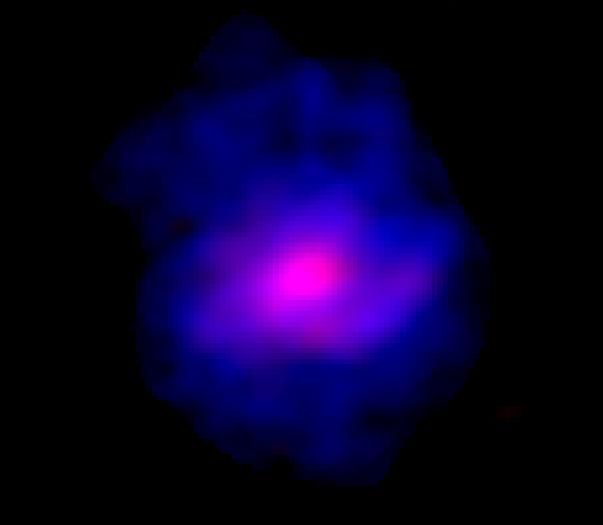
A picture of ALESS 073.1 just 1.2 billion years after the Big Bang.
Cardiff University
How do galaxies grow? Conventional wisdom has it that young galaxies were messy collections of stars and gas clouds that merge and collide with each other. Only after billions of years can they evolve a settled, ordered and complex structure of spiral arms and central bulges of stars—just like our galaxy, the 13.5 billion years old Milky Way.
So how have astronomers found a “baby” galaxy that formed just after the “Big Bang” that’s got the same kind if complex structure as mature galaxies?
Published in Science today is an intriguing paper from a team led by scientists at Cardiff University in Wales, U.K. about the discovery of a galaxy called ALESS 073.1, which appears to have all of the features expected of a much older galaxy.
What they found in the depths of cosmic time—12 billion years back, to be precise—defies explanation.
How did astronomers see so far back in time?
All astronomy is time-travel since all the light we see has traveled vast distances over time to reach us (even sunlight takes eight minutes to get here from the Sun)—but ALESS 073.1 is a really far away galaxy.
They used the Atacama Large Millimeter/submillimeter Array (ALMA), a radio telescope in Chile, as a “time machine” to study it over 12 billion years in the past—and just 1.2 billion years after the Big Bang.
That’s nowhere near old enough for a galaxy to have developed the kind of rotating disks, spiral arms, and “bulges” of stars that are characteristic of mature galaxies—and, yet, that’s what the astronomers observed.
The light emitted from the ALESS 073.1 galaxy took billions of years to reach ALMA, which allowed the astronomers to look at the galaxy in its infancy—and take one of the sharpest direct images of a primordial galaxy so far.

Radio telescope antennas at the Atacama Large Millimeter/submillimeter Array (ALMA) at the … [+]
Getty Images
What’s so special about this galaxy?
Its bulge, which contains about half of its stars, and also a hint of spiral arm structure typical of far older galaxies.
A galaxy having a tightly packed group of stars at its center is associated with mature galaxies many billions of years old. It was thought that bulges in galaxies form slowly as smaller galaxies merge with each other, but with ALESS 073.1 that’s not the case—it’s budge has formed very fast.
Ditto its spiral arms, well-organized structures that were not thought to be possible in young galaxies at an early stage of their evolution, which are mostly chaotic and turbulent.
“This galaxy looks like a grown adult, but it should be just a little child,” said lead author of the study Dr. Federico Lelli, who undertook the work at Cardiff University’s School of Physics and Astronomy. “We discovered that a massive bulge, a regular rotating disk, and possibly spiral arms were already in place in this galaxy when the Universe was just 10% of its current age … it defies our understanding of galaxy formation.”

The spiral arms and dust clouds in the nearby Whirlpool galaxy. Hubble Space Telescope (HST). (Photo … [+]
Universal Images Group via Getty Images
Why is this discover so important?
“This spectacular discovery challenges our current understanding of how galaxies form because we believed these features only arose in mature galaxies, not in young ones,” said Dr. Timothy Davis the School of Physics and Astronomy and co-author of the study.
Wishing you clear skies and wide eyes.
This article is auto-generated by Algorithm Source: www.forbes.com


